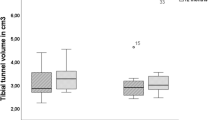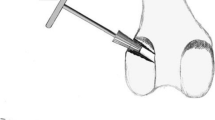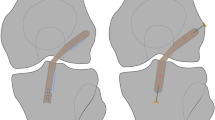Abstract
Background
The aim of this study was to evaluate the impact of different widths of the bony bridge between the femoral AM and PL bundle tunnel and different fixation techniques on the structural properties of the graft/femur complex in double-bundle ACL reconstructions.
Hypothesis
Double-bundle ACL reconstruction with a bony bridge between AM and PL bundle tunnel of 1 mm results in significantly lower structural properties of the graft/femur complex when compared to a bridge of 2 and 3 mm. Interference screw fixation significantly lowers the structural properties when compared to cortical fixation.
Study design
Controlled laboratory study.
Methods
Double-bundle ACL reconstructions using different bridge widths (1 mm, 2 mm, and 3 mm bridge) were loaded to failure after a cyclic loading protocol (1,000 cycles 0–200 N) and the structural properties were compared to a single-bundle ACL reconstruction group (n = 10 in each group). The structural properties of using a cortical button fixation were then compared to interference screw fixation (2 mm bridge). Statistical analyses were performed using a Mann–Whitney test (P < 0.05).
Results
Double-bundle reconstructions with cortical button fixation (1, 2, and 3 mm bridge) showed significantly higher ultimate failure loads and stiffness and significantly lower elongation compared to single-bundle reconstructions. Double-bundle ACL reconstructions with a 1 mm bridge showed significantly reduced structural properties of the graft/femur complex compared to a 2 or 3 mm bridge. Aperture fixation led to significantly lower ultimate loads when compared to cortical fixation.
Conclusion
The bony bridge between the two femoral tunnels in double-bundle ACL reconstructions influences the stability of the graft/femur complex. Aperture fixation using interference screws shows inferior results when compared to cortical fixation.
Clinical relevance
The results suggest that the indication for anatomical ACL reconstruction may include the size of the lateral femoral condyle. In small knees, a second femoral tunnel may be difficult to locate with a minimum bridge width of 2 mm.



Similar content being viewed by others
References
Aglietti P, Giron F, Cuomo P, Losco M, Mondanelli N (2007) Single and double-incision double-bundle ACL reconstruction. Clin Orthop Relat Res 454:108–113
Beynnon BD, Johnson RJ, Abate JA, Fleming BC, Nichols CE (2005) Treatment of anterior cruciate ligament injuries, part I. Am J Sports Med 33(10):1579–1602
Brucker PU, Lorenz S, Imhoff AB (2006) Aperture fixation in arthroscopic anterior cruciate ligament double-bundle reconstruction. Arthroscopy 22(11):1250–1256
Butler DL (1989) Kappa delta award paper. Anterior cruciate ligament: its normal response and replacement. J Orthop Res 7(6):910–921
Chhabra A, Starman JS, Ferretti M, Vidal AF, Zantop T, Fu FH (2006) Anatomic, radiographic, biomechanical, and kinematic evaluation of the anterior cruciate ligament and its two functional bundles. J Bone Joint Surg Am 88:2–10
Dandy DJ (1981) Arthroscopic surgery of the knee. Churchill Livingstone, Edinburgh London New York, pp 67–68
Girgis FG, Marshall JL, Monajem A (1975) The cruciate ligaments of the knee joint. Anatomical, functional and experimental analysis. Clin Orthop 106:216–231
Harner CD, Poehling GG (2004) Double bundle or double trouble? Arthroscopy 20(10):1013–1014
Järvelä T (2007) Double-bundle versus single-bundle anterior cruciate reconstruction: a prospective, randomize clinical study. Knee Surg Sports Traumatol Arthrosc 15(5):500–507
Mithoefer K, Gill TJ, Vrahas MS (2005) Supracondylar femoral fracture after arthroscopic reconstruction of the anterior cruciate ligament. A case report. J Bone Joint Surg Am 87:1591–1596
Nagarkatti DG, McKeon BP, Donahue BS (2001) Mechanical evaluation of a soft tissue interference screw in free tendon anterior cruciate ligament graft fixation. Am J Sports Med 29:67–71
Palmer I (1938) On the injuries of the ligaments of the knee joint: a clinical study. Acta chirur scand 91:1–282
Petersen W, Tillmann B (2002) Anatomy and function of the anterior cruciate ligament. Orthopäde 31:710–718
Petersen W, Tretow H, Weimann A, Herbort M, Fu FH, Raschke M, Zantop T (2007) Biomechanical evaluation of two techniques for double-bundle anterior cruciate ligament reconstruction: one tibial tunnel versus two tibial tunnels. Am J Sports Med 35:228–234
Petersen W, Zantop T (2007) Clinical anatomy of the ACL with regard to its two bundles. Clin Orthop Relat Res 454:35–47
Siebold R (2007) Observations on bone tunnel enlargement after double-bundle anterior cruciate ligament reconstruction. Arthroscopy 23(3):291–298
Singhatat W, Lawhorn KW, Howell SM, Hull ML (2002) How four weeks of implantation affect the strength and stiffness of a tendon graft in a bone tunnel: a study of two fixation devices in an extraarticular model in ovine. Am J Sports Med 30(4):506–513
Weiler A, Hoffmann RFG, Bail HJ, Rehm O, Südkamp NP (2002) Tendon healing in a bone tunnel. Part II: histologic analysis after biodegradable interference fit fixation in a model of anterior cruciate ligament reconstruction in sheep. Arthroscopy 18(2):124–135
Xerogeanes JW, Fox RJ, Takeda Y, Kim HS, Ishibashi Y, Carlin GJ, Woo SL (1998) A functional comparison of animal anterior cruciate ligament models to the human anterior cruciate ligament. An Biomed Eng 26:345–352
Yagi M, Kuroda R, Nagamune K, Yoshida S, Kurosaka M (2007) Double-bundle ACL reconstruction can improve rotational stability. Clin Orthop Relat Res 454:100–107
Yagi M, Wong EK, Kanamori A, Debski RE, Fu FH, Woo SL (2002) Biomechanical analysis of an anterior cruciate ligament reconstruction. Am J Sports Med 30(5):660–666
Yasuda K, Kondo E, Ichiyama H, Tanabe Y, Tohyama H (2006) Clinical evaluation of anatomic double-bundle anterior cruciate ligament reconstruction procedure using hamstring tendon grafts: comparisons among 3 different procedures. Arthroscopy 22(3):240–251
Zantop T, Herbort M, Raschke MJ, Fu FH, Petersen W (2007) The role of the anteromedial and posterolateral bundles of the anterior cruciate ligament in anterior tibial translation and internal rotation. Am J Sports Med 35(2):223–227
Zantop T, Kubo S, Petersen W, Musahl V, Fu FH (2007) Current techniques in anatomic anterior cruciate ligament reconstruction. Arthroscopy 23(9):938–947
Zantop T, Weimann A, Wolle K, Musahl V, Langer M, Petersen W (2007) Initial and 6 weeks postoperative structural properties of soft tissue anterior cruciate ligament reconstruction with cross-pin or interference screw fixation: an in vivo study in sheep. Arthroscopy 23(1):14–20
Author information
Authors and Affiliations
Corresponding author
Rights and permissions
About this article
Cite this article
Lehmann, AK., Osada, N., Zantop, T. et al. Femoral bridge stability in double-bundle ACL reconstruction: impact of bridge width and different fixation techniques on the structural properties of the graft/femur complex. Arch Orthop Trauma Surg 129, 1127–1132 (2009). https://doi.org/10.1007/s00402-009-0869-x
Received:
Published:
Issue Date:
DOI: https://doi.org/10.1007/s00402-009-0869-x




